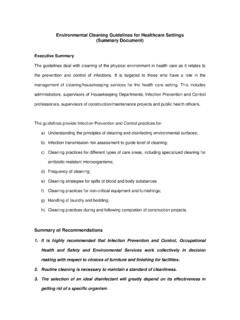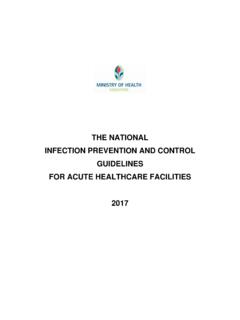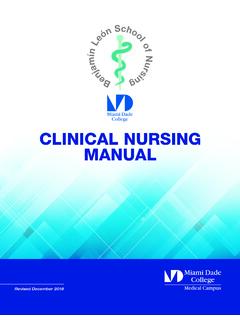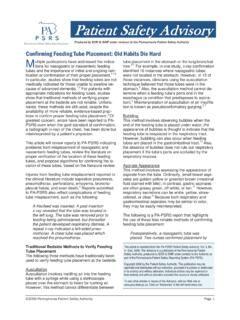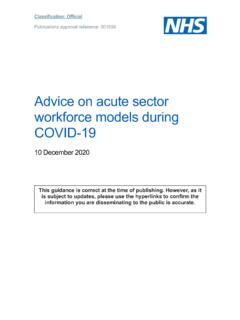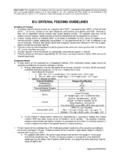Transcription of Nursing Management of Nasogastric Tube Feeding in …
1 MOH Nursing CLINICAL PRACTICE GUIDELINES 1/2010 Nursing Management of Nasogastric Tube Feeding in Adult Patients July 2010i STATEMENT OF INTENT This set of guidelines serves as a guide for caregivers of adults with Nasogastric tube Feeding . The recommendations are based on the available research findings and existing evidence-based guidelines. However there are some aspects in which there are insufficient published researches and therefore, consensus of expert in the field has been utilized to provide guidelines specific to conventional practice. As practitioners, each individual must exercise clinical judgement in the Nursing Management of patients with Nasogastric tube Feeding .
2 Therefore, these guidelines should be implemented according to individual patient s condition, overall treatment goal, resource availability, institutional policies and treatment options available. Copyright 2010 by Ministry of Health, Singapore. ii FOREWORD Every careful observer of the sick will agree in this that thousands of patients are annually starved in the midst of plenty, from want of attention to the ways which alone make it possible for them to take food. Florence Nightingale, 1859 Nurses have recognised the importance of meeting patients nutritional needs since the beginning of our profession. Enteral nutrition is the preferred Feeding method for those patients with normal functioning gastrointestinal tracts but with inability to ingest adequate nutrients solely by mouth.
3 Significant advances and changes have since evolved in nutritional care of hospitalised patients. Enteral nutrition as compared to parenteral Feeding , is considered to be safer and less expensive. Nurses have always assumed the role of providing nutritional therapy to patients. They would find the publication of this clinical practice guidelines timely and useful to guide them in enteral nutrition therapy. Adhering closely to these guidelines would significantly reduce and, in many instances, prevent complications commonly associated with enteral Feeding . PAULINE TAN CJ CHIEF Nursing OFFICER iii CONTENTS 1 INTRODUCTION 1 Background 1 Definition of Nasogastric Tube Feeding 1 Highlights of Patient Management 2 Scope of the Guidelines 2 2 DEVELOPMENT OF GUIDELINES 3 Training and Guidelines 3 Strategy and Literature Review 3 Evaluation of Evidence and Grading of Recommendations 3 Individual Study Validity Rating 4 Levels of Evidence 5 Grade of Recommendation 6 Interpretation of the D/4 Grading 6 Guideline Review and Revision 7 Limitations
4 7 3 ALGORITHM FOR Management OF Nasogastric TUBE Feeding 8 4 SELECTION OF Nasogastric tubes 9 Feeding Tube Selection 9 5 Nasogastric tubes PLACEMENT AND care 10 Tube Insertion and Stabilization 10 pH Testing 10 iv Radiological Determination of Feeding Tube Placement 12 Auscultatory Method 13 Frequency in Checking Placement 14 Tube Clogging 14 Maintaining Tube Patency 14 6 ADMINISTRATION OF Nasogastric TUBE Feeding 16 Preparation of Formula Feeds and Delivery System 16 Feeding Position 17 Bolus Feeding 17 Continuous Feeding 18 Prevention of Diarrhoea 19 7 ADMINISTRATION OF MEDICATIONS 21 Administration of Medications 21 8 MONITORING AND Management 23 Monitoring and Management of Gastro-intestinal Tolerance 23 9 COMPLICATIONS 25 Management of Feeding Intolerance 25 Declogging 25 Diarrhoea 26 Assessment / Monitoring 26 Treatment of Diarrhoea 26 Aspiration Pneumonia 27 Feeding Devices 28 v 10 QUALITY ASSURANCE 29 Parameters for Evaluation 29 Incidence of misplaced tubes 29 Incidence of aspiration as a result of Nasogastric tube Feeding 29 Sentinel Events 29 Management Role 30 11 IMPLEMENTATION OF GUIDELINES 31 12 REFERENCES
5 32 13 GLOSSARY 36 14 WORKGROUP MEMBERS 39 APPENDIX 1 Nasogastric TUBE ANCHORING TECHNIQUE 41 APPENDIX 2 ALGORITHM FOR ASSESSING PLACEMENT OF THE Nasogastric TUBE 42 APPENDIX 3 SELF ASSESSMENT 43 1 1 INTRODUCTION Figure 1. Schematic picture of Nasogastric tube Background Patients in the hospital, as well as home care settings, often require nutritional supplementation with enteral Feeding . Enteral Feeding can be administered via Nasogastric , nasoduodenal and nasojejunal means. The focus of this clinical practice guideline is on the Nursing Management of Nasogastric tube Feeding .
6 Nasogastric tube Feeding may be accompanied by complications. Thus, it is important for the practitioner to be aware of how to prevent these complications so that Nasogastric tube Feeding can be administered successfully and safely. Definition of Nasogastric Tube Feeding Nasogastric tube Feeding is defined as the delivery of nutrients from the nasal route into the stomach via a Feeding tube. 2 Highlights of Patient Management Patients and their caregivers are important team players in the effective Management of Nasogastric tube Feeding . The practitioner should: encourage patients and their caregivers to be active participants in their care develop an effective plan of care that is consistent with the patient s goals The recommendations focus on: implementation of Nasogastric tube Feeding monitoring and Management of Nasogastric tube Feeding Management of complications Scope of the Guidelines This set of guidelines is intended as a simple and readable reference for caregivers of adults with Nasogastric tube Feeding .
7 These clinical practice guidelines are tools for assisting clinical decision making with regard to the Nursing care given to a patient with a Nasogastric tube. They are the result of systematic identification and synthesis of published research findings and expert opinions. However, they should be adapted locally to suit a particular situation and patient. It is the intention of the workgroup not to be encyclopaedic in coverage but to produce a concise, readable and practical format that addresses key topics which can be used as a reference and training tool. 3 2 DEVELOPMENT OF GUIDELINES Training and Guidelines Members of the workgroup attended a two-day interactive training workshop to learn about and discuss the theory and practical issues of developing evidence-based guidelines under the guidance of Dr Edwin Chan and Dr Miny Samuel of the then Clinical Trials and Epidemiology Research Unit.
8 The practical training revolved around topic selection and the development of mock evidence-based guidelines which developed into this present set of guidelines. Strategy and Literature Review Three highly regarded evidence-based guidelines were reviewed: The Nutrition Support Practice Manual (2nd Edition), The American Society for Parenteral and Enteral Nutrition. 2005 [ASPEN, 2005] Insertion and Management of Nasogastric tubes for Adults. The Joanna Briggs Institute: Systematic Reviews, 2006 [JBI, 2006] Enteral Nutrition Practice Recommendations. 2009 [ASPEN, 2009] The members felt that an updated literature search on the specific topics addressed would suffice. The electronic databases (MEDLINE, EMBASE, Cochrane Library, SPRINGNET and CINAHL) and hard copies of relevant journals (Journal of Parenteral and Enteral Nutrition, Hospital Pharmacy, critical care Nurse, American Journal of critical care , Medical Surgical Nursing , Journal of Clinical Nursing , Consultant Pharmacist, Gastroenterology Nursing , Nursing Research, Heart and Lung) were searched.
9 Evaluation of Evidence and Grading of Recommendations The revised Scottish Intercollegiate Guidelines Network (SIGN) system was adopted as a guide to evaluate the design of individual studies and assign a grade to each study s level of evidence. The recommendation was given a grade after taking into account the external validity, result consistency, local constraints and expert 4 opinion. The extensive reliance on the ASPEN and JBI guidelines are acknowledged and treated as our main published expert opinion. For areas where available evidence is inconsistent or inconclusive, recommendations were made based on the clinical experience and judgement of the workgroup or expert committee reports.
10 Individual Study Validity Rating All primary studies and reviews addressing a particular topic were appraised using a SIGN checklist appropriate to the study's design. These were individually rated for internal validity using the system below: Rating Description ++ All or most of the criteria have been fulfilled. Where they have not been fulfilled the conclusions of the study or review are thought very unlikely to alter. + Some of the criteria have been fulfilled. Those criteria that have not been fulfilled or not adequately described are thought unlikely to alter the conclusions. Few or no criteria fulfilled. The conclusions of the study are thought likely or very likely to alter.

